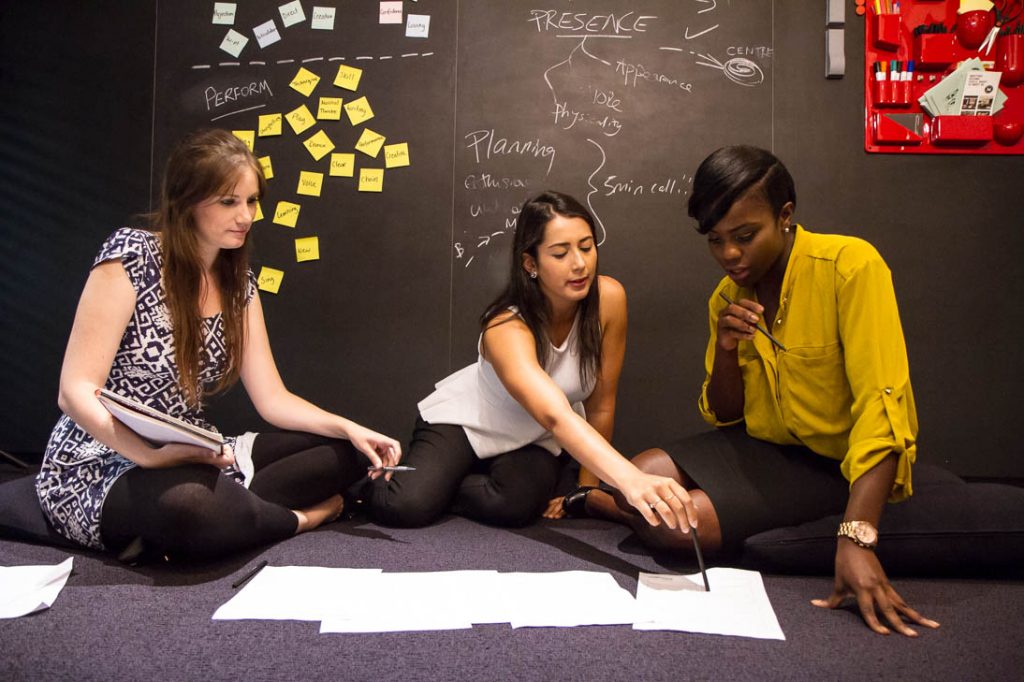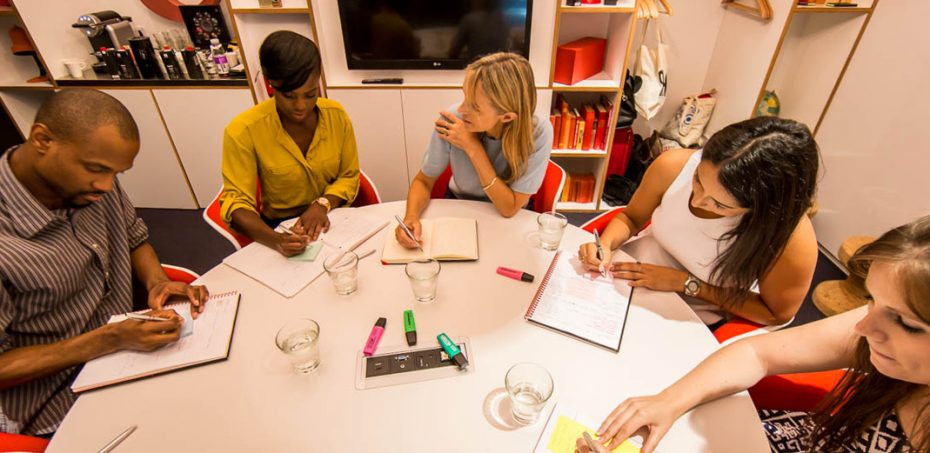It’s not uncommon for meetings to be formal affairs that are made up of a lot of strong characters, so it can often be pretty intimidating to bring a bit of yourself to the table and share a piece your mind. Assertiveness training can help keep you mindful of your performance, presentation and vocals.
Being prepared and arriving on time are the basics and easier to put into practice, what this article draws attention to is the subtler challenges of feeling comfortable in the environment of a meeting. Here are the 3 insider secrets to having a presence and making your impact felt, with expert tips from Harriet Whitbread - graduate of The Royal Central School of Speech and Drama, and City Academy voice tutor.
Create the right body language
 Body language accounts for 55% of your communication, so if you get this right you are over halfway there. Get it wrong and it doesn’t matter how eloquently you speak, because you will be ‘seen’ a certain way - the first impression will be that you cannot communicate effectively. This is where assertiveness training comes in.
Body language accounts for 55% of your communication, so if you get this right you are over halfway there. Get it wrong and it doesn’t matter how eloquently you speak, because you will be ‘seen’ a certain way - the first impression will be that you cannot communicate effectively. This is where assertiveness training comes in.
We can divide body language into three types: open, neutral and closed, and these can all be used to great effect in different domains.
A neutral body position that is assertive, alert and non-threatening is the perfect default position for a meeting. When you next attend one, take some time to become aware of how you normally sit in situ, and try to slowly bring it in line with the ideal by asking yourself the following:
- Where am I sitting on the chair?
If you are on the edge of it, this could be seen as bored (if leaning back), nervous (if upright) or eager (if leaning forward). Your upper body is invariably in plain sight and when at a table, it is the most visible part of you, so always consider what message the posture of your torso is sending out. The thing to do here is place yourself in the back of the chair and keep your back straight.
- What are my legs doing?
Are they crossed or twisted round each other? Although this feels comfortable and is the most common leg position, it is actually closed body language and can be seen as defensive - even if that’s not at all how you feel. On the flip side, sitting with your legs open can often be seen as aggressive by women and domineering by men, particularly if you are leaning back at the same time. So how what do you do? Plant your feet firmly on the floor and have your legs uncrossed, with your knees pointing in front of you.
- Erm, what about my arms and hands?
As a neutral starting point, make sure your arms are unfolded, and try not to fidget or support your head with your hand. Have both hands on the table, with one hand relaxed and palm side down, and the other with palm upwards. Arms and hands are beautifully expressive, so move freely and use them to gesture, just beware of pointed fingers and claw like shapes that can look aggressive.
Listen with more than just your ears
 Your body isn’t only playing a role when you are being expressive, it is also making an impact while you listen, and listening is the foundation of best practice in a meeting.
Your body isn’t only playing a role when you are being expressive, it is also making an impact while you listen, and listening is the foundation of best practice in a meeting.
How do you listen? How does your body listen? There are infinite possibilities in regards to what you’re saying with your body language while listening. You may lean back in your chair, close your eyes, fidget and clench your fists, doodle on the paper in front of you, or drop your chin down to your chest.
All of this is influenced by what you’re thinking. Assertiveness training tells us that what’s going on up there has ramifications on what’s going on out here. If you’re waiting for a chance to interrupt, pondering what you’re having for dinner, judging the person who speaking, or thinking about how much you disagree, it’ll show.
So, mentally, make sure you are not thinking about something else; the aim in a meeting is to understand and respect the speaker’s opinion, even if you disagree with it. Physically, you want to adopt a neutral body position, using appropriate verbal and nonverbal responses. Don’t forget to look at the person, eye contact is vital in letting the speaker, and everyone else in the room, know you that you are not just listening, but listening ‘actively’.
Use assertiveness training and vocal tactics to make yourself heard
 Aside from the golden rule of prepare, prepare, prepare - there is the feat of making sure what you’ve prepared is actually heard and taken into consideration. Because sometimes, our bodies can sabotage the points we are trying to make.
Aside from the golden rule of prepare, prepare, prepare - there is the feat of making sure what you’ve prepared is actually heard and taken into consideration. Because sometimes, our bodies can sabotage the points we are trying to make.
When nerves strike, our throats can suddenly decide to feel dry and croaky (to prevent this, drink at least half a litre of water prior to a meeting), and they can even cause us to close up our throats and hold our breath in. This commonly tends to happen on an intake of breath, so it’s important to check you have inhaled without interruption before you speak. It sounds very obvious, but it’s surprising how often people begin speaking half way through a breath out, when their voice will naturally lose wind and resonate less.
If you find your voice comes out as a squeak, or doesn’t sound like yourself, it is most likely to be because nerves have caused the throat to constrict. The muscles are pressing against the larynx and in effect ‘strangling’ the voice. What type of assertiveness training can you implement here? The best thing is actually a long, wide yawn - which is obviously bad practice in a meeting. The next best thing is a closed mouth yawn, and it’s best to try this at home first so you can nail the technique in a subtle way.
First yawn normally and see if you can identify the moment when the back of the mouth feels like it is wide open - this is called the raising of the soft palate. Now yawn with your mouth closed and see if you can spot the same feeling. Then try to recreate that feeling about a minute before you speak - keeping your lips tight and your expression undisturbed. If you can train your soft palate to rise without becoming teary eyed, cracking into a stretch and getting ready for bed, you can counteract the closing effect of nerves, and conquer them mid-meeting.
Lastly, make sure you open your mouth whilst speaking - the tongue is the articulator or ‘shaper’ of spoken sounds, but most of us tend to speak through an almost closed mouth. We leave very little room for the tongue to manoeuvre and the jaw tries to step in to do its job instead, making for muffled speech and low volume vocals. If anyone has ever asked you to slow down, speak up or repeat something, this is why. Practice saying ‘the lazy brown fox jumped over the fence’, first as you would, and then trying purposefully to keep the mouth open and maintain clear pronunciation, using the tongue to articulate.
Learn more about presence and impact in the form of a bespoke workshop, tailored to your organisation's needs. For further assertiveness training, communication skills courses, team building days and event experiences, please see our business section.
City Academy also runs public courses on presence and impact for individuals. Or, choose a City Academy life skills workshop to work on your performance, presentation and vocal skills.








